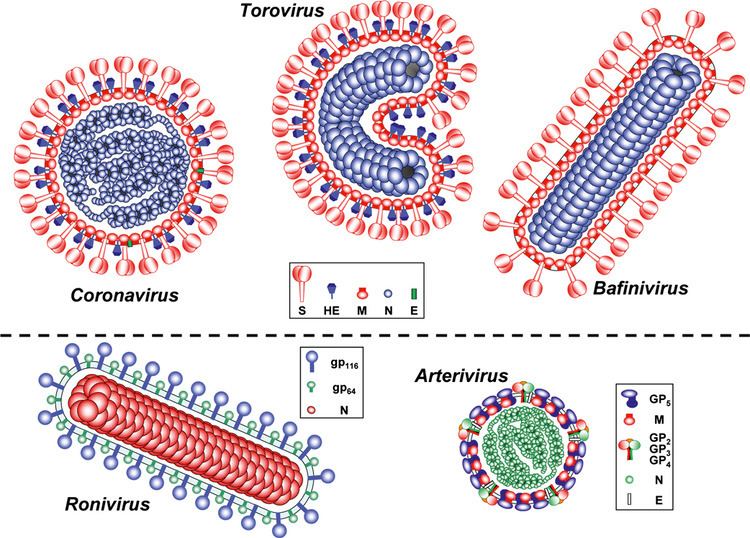Scientific name Nidovirales Rank Order | ||
 | ||
Lower classifications Coronavirus, Coronaviridae | ||
Medical vocabulary what does nidovirales mean
Nidovirales is an order of viruses with animal and human hosts (MERS-CoV and SARS-CoV). It includes the families Coronaviridae, Arterivirus, Roniviridae and Mesoniviridae.
Contents
The order Nidovirales is named for the Latin nidus, meaning nest, as all viruses in this order produce a 3' co-terminal nested set of subgenomic mRNA's during infection.
Medical vocabulary what does nidovirales mean
Virology
This group consists of viruses which have positive-sense, single-stranded RNA genomes. As positive-sense genomes, the viruses can use some host cell proteins during replication and gene expression which occurs in the cytoplasm of the host cell.
This group of viruses expresses structural proteins separately from the nonstructural ones. The structural proteins are encoded at the 3’ region of the genome and are expressed from a set of subgenomic mRNAs. These viruses encode one main proteinase and between one and three accessory proteinases which are mainly involved in expressing the replicase gene. These proteinases are also responsible for activating or inactivating specific proteins at the correct time in the virus life cycle, ensuring replication occurs at the right time.
A large number of proteins have been identified on the genomes of Nidovirales, but their function has not yet been determined. Other enzymes that may be present in the genome include papain-like proteases, ADP-ribose/poly(ADP-ribose)-binding and/or ADP-ribose 1''-phosphate phosphatase activities and cyclic nucleotide phosphodiesterase.
Most, but not all, nidovirus subgenomic RNAs contain a 5′ leader sequence derived from the 5′ end of the genomic RNA.
The frameshift that generates ORF1b frameshift occurs at a UUUAAAC heptanucleotide 'slippery' sequence located upstream of the ORF1a stop codon and a putative RNA pseudoknot structure.
The virus which has the largest known nonsegmented RNA genome of 31.5kb, the mouse hepatitis virus (MHV), is of the order nidovirales.
Taxonomy
This order of viruses can be distinguished from other RNA viruses by a constellation of seven conserved domains—5'-TM2-3CLpro-TM3-RdRp-Zm-HEL1-NendoU-3'—with the first three being encoded in ORF1a and the remaining four in ORF1b. TM2 and TM3 and transmembrane domains; RdRp is the RNA polymerase; Zm is a Zn-cluster binding domain fused with a helicase (HEL1); 3CLpro is a 3C-like protease; and NendoU is an uridylate-specific endonuclease. The 3CLpro has a catalytic His-Cys dyad.
The Nidovirales can be divided into two clades depending on the size of the genome: those with large genomes (26.3–31.7 kilobases) which included the Coronaviridae and Roniviridae (the large nidoviruses) and those with small genomes (the small nidoviruses)—a clade that includes the distantly related Arteriviridae (12.7–15.7 kb). The large nidoviruses encode both an 2'-O-methyltransferase and a 3'–5' exoribonuclease (ExoN)—the latter being very unusual for an RNA virus. They also encode a superfamily 1 helicase, uridylate-specific endonuclease (an enzyme unique to nidoviruses) and several proteases.
Notes
Nidovirales belongs to Group IV of the Baltimore classification system.
A virus belonging to this group—Cavally virus—has been isolated from mosquitoes. It appears to be unrelated to the other member of this order and probably is the first member of a new family.
Another virus has been isolated from mosquitoes—Nam Dinh virus—that appears to belong a new family in this order.
Cavally virus and Nam Dinh virus have been identified as two serotypes of the same species, Alphamesonivirus 1, and placed in a newly discovered family—Mesoniviridae.
Gill-associated virus and yellow head virus, both isolated from prawns, are members of this order. These latter two viruses have been classified into the family Roniviridae genus Okavirus.
Another virus—white bream virus—isolated from fish may also belong to this order.
